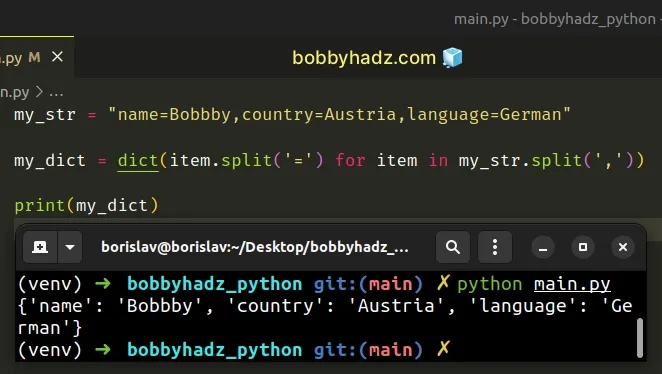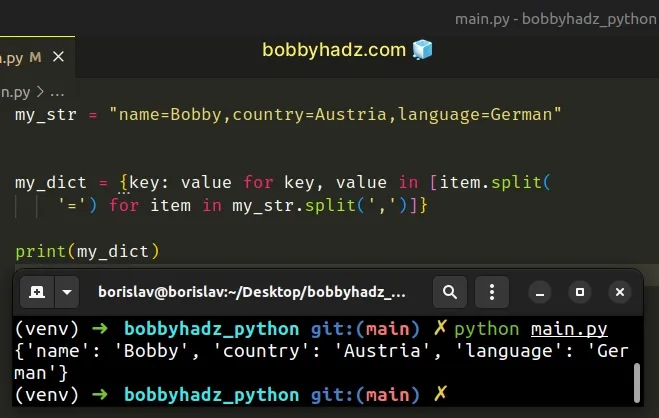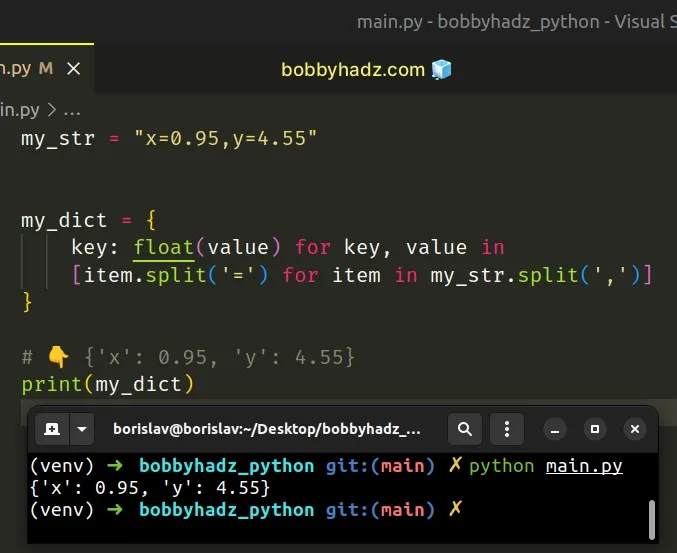Convert a comma-separated String to a Dictionary in Python
Last updated: Apr 9, 2024
Reading time·6 min

# Table of Contents
- Convert a comma-separated String to a Dictionary in Python
- Convert a Dictionary to a comma-separated String in Python
- Convert string representation of Dict to Dict in Python
- Split strings in a List into key-value pairs (dict) in Python
# Convert a comma-separated String to a Dictionary in Python
To convert a comma-separated string to a dictionary:
- Use the
str.split()method to split the string on each comma. - Split each string in the list on the delimiter between the key-value pairs.
- Pass the results to the
dict()class.
my_str = "name=Bobbby,country=Austria,language=German" my_dict = dict(item.split('=') for item in my_str.split(',')) # 👇️ {'name': 'Bobbby', 'country': 'Austria', 'language': 'German'} print(my_dict)

The example uses the dict() class to convert a comma-separated string to a
dictionary.
The first step is to split the string on each comma, semi-colon or any other character that separates the key-value pairs.
my_str = "name=Bobby,country=Austria,language=German" # 👇️ ['name=Bobby', 'country=Austria', 'language=German'] print(my_str.split(','))
The next step is to use a generator expression to iterate over the list and split each string on the character that separates the keys and values.
my_str = "name=Bobby,country=Austria,language=German" my_dict = dict(item.split('=') for item in my_str.split(',')) # 👇️ {'name': 'Bobby', 'country': 'Austria', 'language': 'German'} print(my_dict)
The str.split() method splits the string into a list of substrings using a delimiter.
The method takes the following 2 parameters:
| Name | Description |
|---|---|
separator | Split the string into substrings on each occurrence of the separator |
maxsplit | At most maxsplit splits are done (optional) |
If the keys and values in your string are separated by colons, make sure to
update the separator in the call to the str.split() method.
my_str = "name:Bobby,country:Austria,language:German" my_dict = dict(item.split(':') for item in my_str.split(',')) # 👇️ {'name': 'Bobby', 'country': 'Austria', 'language': 'German'} print(my_dict)
# Convert a comma-separated String to a Dictionary using a dict comprehension
Alternatively, you can use a dict comprehension.
my_str = "name=Bobby,country=Austria,language=German" my_dict = {key: value for key, value in [item.split( '=') for item in my_str.split(',')]} # 👇️ {'name': 'Bobby', 'country': 'Austria', 'language': 'German'} print(my_dict)

Dict comprehensions are very similar to list comprehensions.
# Convert numeric values to integers or floats
If the values in your dictionary are numbers, use the int() or float() classes to convert them.
my_str = "x=0.95,y=4.55" my_dict = { key: float(value) for key, value in [item.split('=') for item in my_str.split(',')] } # 👇️ {'x': 0.95, 'y': 4.55} print(my_dict)

We used the float() class to convert each value to a floating-point number.
You would use the int() class if you need to convert numeric values to
integers.
# Convert a Dictionary to a comma-separated String in Python
To convert a dictionary to a comma-separated string:
- Use the
str.keys()orstr.values()method to get a view of the dictionary's keys or values. - Use the
str.join()method to join the keys or values with a comma separator.
my_dict = {'name': 'Bobby', 'age': 30, 'salary': 100} # ✅ Convert a dictionary's keys to a comma-separated string keys_str = ','.join(my_dict.keys()) print(keys_str) # 👉️ 'name,age,salary' # --------------------------------------------- # ✅ Convert a dictionary's values to a comma-separated string values_str = ','.join(str(value) for value in my_dict.values()) print(values_str) # 👉️ 'Bobby,30,100'
The example uses the dict.keys() method to get a view of the dictionary's
keys.
The dict.keys() method returns a new view of the dictionary's keys.
The dict.values() method returns a new view of the dictionary's values.
The last step is to use the str.join() method to join the dictionary's keys or
values into a string with a comma separator.
my_dict = {'name': 'Bobby', 'age': 30, 'salary': 100} keys_str = ','.join(my_dict.keys()) print(keys_str) # 👉️ 'name,age,salary' values_str = ','.join(str(value) for value in my_dict.values()) print(values_str) # 👉️ 'Bobby,30,100'
The str.join() method takes an iterable as an argument and returns a string which is the concatenation of the strings in the iterable.
TypeError if there are any non-string values in the iterable.If your iterable contains numbers or other types, convert all of the values to
string before calling join().
The string the method is called on is used as the separator between the elements.
We used a comma in the examples. If you need to separate the values with a comma followed by a space, make sure to adjust the string the method is called on.
my_dict = {'name': 'Bobby', 'age': 30, 'salary': 100} keys_str = ', '.join(my_dict.keys()) print(keys_str) # 👉️ 'name, age, salary' values_str = ', '.join(str(value) for value in my_dict.values()) print(values_str) # 👉️ 'Bobby, 30, 100'
# Convert a dictionary's items to a comma-separated string
If you need to convert a dictionary to a comma-separated string containing the
dictionary's keys and values, use the dict.items() method.
my_dict = {'name': 'Bobby', 'age': 30, 'salary': 100} dict_str = ", ".join("=".join([key, str(value)]) for key, value in my_dict.items()) print(dict_str) # 👉️ name=Bobby, age=30, salary=100
The dict.items() method returns a new view of the dictionary's items ((key, value) pairs).
my_dict = {'name': 'Bobby', 'age': 30, 'salary': 100} # 👇️ dict_items([('name', 'Bobby'), ('age', 30), ('salary', 100)]) print(my_dict.items())
We used the join() method to join each key-value pair with an equal sign
separator and then used the join() method again to join the key-value pairs
with a comma-separator.
# Convert string representation of Dict to Dict in Python
Use the ast.literal_eval() method to convert the string representation of a
dictionary to a dictionary.
The ast.literal_eval() method allows us to safely evaluate a string that
contains a Python literal.
from ast import literal_eval import json my_str = '{"id": 0, "name": "Bobby", "salary": 100}' my_dict = literal_eval(my_str) print(my_dict) # 👉️ {'id': 0, 'name': 'Bobby', 'salary': 100} print(type(my_dict)) # 👉️ <class 'dict'>
The example uses the ast.literal_eval() method to convert the string
representation of a dictionary to an actual dictionary.
The ast.literal_eval() method allows us to safely evaluate a string that contains a Python literal.
# Convert string representation of Dict to Dict using json.loads()
Alternatively, you can use the json.loads() method.
import json my_str = '{"id": 0, "name": "Bobby", "salary": 100}' my_dict = json.loads(my_str) print(my_dict) # 👉️ {'id': 0, 'name': 'Bobby', 'salary': 100} print(type(my_dict)) # 👉️ <class 'dict'>
We used the json.loads() method to parse the string representation of a
dictionary to a native dict object.
json.loads() method can only be used if you have a valid JSON string.For example, the keys and values have to be double-quoted. This wouldn't work if the keys or values are wrapped in single quotes.
The json.loads() method parses a JSON string into a native Python object.
import json json_str = '{"name": "Bobby", "age": 30}' my_dict = json.loads(json_str) print(type(my_dict)) # 👉️ <class 'dict'>
If the data being parsed is not a valid JSON string, a JSONDecodeError is
raised.
# Convert string representation of Dict to Dict using PyYAML
If your string isn't valid JSON, you can use the PyYAML module.
First, install the module by running the pip install pyyaml command.
pip install pyyaml # 👇️ or with pip3 pip3 install pyyaml
Now you can import the module and use it to parse the string into a native Python dictionary.
import yaml my_str = "{'id': 0, 'name': 'Bobby', 'salary': 100}" my_dict = yaml.full_load(my_str) print(my_dict) # 👉️ {'id': 0, 'name': 'Bobby', 'salary': 100} print(type(my_dict)) # 👉️ <class 'dict'>
yaml.full_load() method takes a YAML document, parses it and produces the corresponding Python object.Note that using the full_load() method with untrusted input is not
recommended.
If you're working with untrusted data, use the yaml.safe_load() method
instead.
import yaml my_str = "{'id': 0, 'name': 'Bobby', 'salary': 100}" my_dict = yaml.safe_load(my_str) print(my_dict) # 👉️ {'id': 0, 'name': 'Bobby', 'salary': 100} print(type(my_dict)) # 👉️ <class 'dict'>
The yaml.safe_load() method loads a subset of the YAML language. This is
recommended for loading untrusted input.
# Split strings in a List into key-value pairs (dict) in Python
To split strings in a list into key-value pairs:
- Use a generator expression to split the strings in the list into nested lists of key-value pairs.
- Pass the two-dimensional list to the
dict()class.
my_list = ['name=Bobby', 'country=Austria', 'job=accountant'] result = dict(kv.split('=') for kv in my_list) # 👇️ {'name': 'Bobby', 'country': 'Austria', 'job': 'accountant'} print(result)
We used a generator expression to split each string in the list into a 2-element list.
# 👇️ [['name', 'Bobby'], ['country', 'Austria'], ['job', 'accountant']] print(list(kv.split('=') for kv in my_list))
The first item in each nested list is the name, and the second is the value.
The dict() class can be passed an iterable of keyword arguments and returns a
new dictionary.
If the values in your dictionary are integers, you can convert them using the
int() class.
my_list = ['name=1', 'country=2', 'job=3'] def convert_to_int(kv): return (kv[0], int(kv[1])) result = dict(convert_to_int(kv.split('=')) for kv in my_list) # 👇️ {'name': 1, 'country': 2, 'job': 3} print(result)
The convert_to_int function gets called with a list containing 2 items - a key
and a value.
It returns a tuple containing the key and the integer version of the value.
I've also written an article on how to convert bytes to a dictionary.
# Additional Resources
You can learn more about the related topics by checking out the following tutorials:

